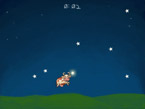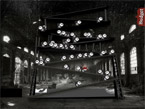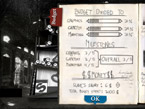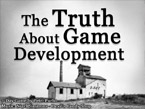March 17th, 2007
Yes I’m alive and back home from the Game Developers Conference. I’m still suffering from a horrible jet-lag (I woke up today at 05:00 AM), and my computer broke down on me (I feel like I’ve lost a family member) and the credit card bill just landed in the mailbox. On top of that I’ve been really busy trying to catch up on all the things I had to postpone because of GDC. So this week’s been really sucky. I think it’s a karma thing, I had too much fun in San Francisco and now karma is punishing me for it. If the conference would have been any more fun, I would have probably died this week.
My presentation at the Experimental Gameplay Session went well in the sense that the audience enjoyed it. I noticed that people tend to share the presentation slides on their blog. So here’s mine: egs_slides.ppt. There isn’t all that much useful information in the slides. I basically put them together to let the people know that the games I presented, could be download from this site. And since your reading this, you probably now that already.
I was going to write about the other people’s games presented at Experimental Gameplay Session, but people with faster blogging skills did that already. I really suck at this rapid blogging of events happening right now. I mean the session happened over a week ago. I blame the jet-lag. Anyway Gamasutra has a brilliant coverage of the event, but unfortunately they missed some games. You can read about them from joystiq and from And Maw! This. And also check out these videos recorded during the session (thanks Louis).
As for the conference, it was great. It was my first GDC, and I really enjoyed it. I got to attend some really great lectures, like Chaim Gingold’s Spore’s Magic Crayons and Raph Koster’s Where Game Meets Web, but my favorite was easily the Nuances of Design session by Jonathan Blow. At the Nuances of Design session we had our own laptops there and we played the games as the designers talked about them. I really hope there will be a Nuances of Design session at GDC 2008.
Other thing I really enjoyed about GDC, was the fact that I got meet all these like minded people, creators of my favorite games and people I look up to as great game developers. Everybody seemed very down to earth, passionate and willing share their ideas. Luckily for my safety I didn’t bump into any grumpy old game developers, who would have no doubt strangled me for my enthusiasm. One of my personal highlights was the fact that I got meet and hang out with Kyle Gray and Kyle Gabler of ExperimentalGameplay.com. They are two of the four guys who inspired me to start creating experimental games in the first place. They’re like my idols, so meeting them was really great.
GDC was such a fun event that I promised already to everybody that I’d be there next year also. I really have to start saving up already, since I might not be as lucky as I was this time 🙂
Posted in General | No Comments »
March 1st, 2007
I’m sorry for the lack of posts in February. I’ve been really busy and I was lucky to get the game out in time. But being busy, is not a valid excuse for lack of updates. Fortunately February has traditionally been a slow month for all the game development blogs, usually because of the Game Developers Conference. And up until this Tuesday I wasn’t sure if I could use the GDC as an excuse for my lack of posts. But luckily I can.
Long story short: I’m going to GDC and I’ll be presenting my games at the Experimental Gameplay Session. And yes I’m very excited about the whole thing, since it’s my first GDC. And I really have to thank Darius Kazemi for the whole shenanigans, since he was the one who encouraged me to send my games to the EGW. And Frozenbyte (game development company I work for) for sponsoring my trip, I really couldn’t have afforded to travel there with out their financial support. And the boys and girls (they are actually all older than me, so maybe I should call them grandpa’s and grandma’s) of Experimental Gameplay Workshop for having me there in the first place.
I’ll try to make at least some kind of notes about the other games presented at the Experimental Gameplay Workshop and post them here, since there are some very cool games there. I know since I’ve seen the schedule of the session.
Edit: If any of you who read this blog will be at the GDC this year, drop by and say hi after the session.
Posted in General | No Comments »
March 1st, 2007
Here’s my 7th experimental done-in-under-a-week game. It’s my take on the one button design challenge, that seems to pop up every now and then on every game development forum that I read.
Moo at the Moon



Download
Moo.zip (3.6 Mb) (Release 1)
Instructions
As the full moon rises, nature’s most savage beast (cows) reveal their true nature: their ability to fly.
You play as one of the cows, who tries to jump over the moon. The game is played by only using your left mouse button. When you press down on the mouse button the cow clings to the nearest star. Try to jump from star to star and reach the moon.
Esc – Will quit the game.
Alt + enter – Will toggle fullscreen.
Credits
Game Design, Code & Gfx: Petri Purho ( petri.purho (at) gmail.com )
Music: Dance Orchestra – Blue Danube Waltz.
Sound Effects: From acclivity’s TwoCows.wav, licensed under a Creative Commons Sampling Plus 1.0 License.
Thanks
Physics model is based on Markus Ilmola’s tutorials.
Inspiration source: Experimental Gameplay Project.
Moo at the Moon uses: SDL, SDL_Image, SDL_Mixer and SDL_RotoZoom
Posted in Games | No Comments »
February 12th, 2007
The new version of Kloonigames Blog is here! On Thursday night I (finally) installed the new version (2.1.) of WordPress, plugged in the Sociable plug-in and then I started dreaming that perhaps I could also create a new layout for the site. I mean how hard could that possibly be. I used to do sites, back when Netscape Communicator 4.7 was the hottest browser and tables and invisible images where the formating choice of the professionals. Few years ago I briefly created some sites using XHTML and CSS and back then I thought it was easier to do a cross-browser layout with tables than it was with CSS. Luckily things haven’t changed a lot, it’s still a bitch to create a good cross-browser layout with CSS.

Well it turned out that it takes few days to get a new layout working in both Internet Explorer and Firefox. Well it doesn’t work perfectly in IE, but I consider it as a form of a punishment for the people using IE as their primary browser. And if you dear reader are one of those pagans (I know that 31% of you are), who still mainly uses Internet Explorer, do yourself a favor and download Mozilla Firefox.
Enough ranting. The new layout is here and I hope you like it. There’s the screenshot of the old site to refresh your memory and to see what has changed. Let me know, what you think of the new one. And also please report if (and when) you find out that something isn’t working as it should be.
Posted in General | No Comments »
February 1st, 2007
Here’s my 6th done-in-a-week game. This time I was inspired by Darius Kazemi’s game design challenge and by the quality of life issues of game industry.
The Truth About Game Development



Download
Tagd.zip (8.1 Mb) (Release 1)
Instructions
You play the part of a game producer and your job is to produce the best game you can as cheaply as possible.
Mostly you just try to motivate the lazy ass game developers by killing them.
Esc – Will quit the game.
Alt + enter – Will toggle fullscreen.
Credits
Game Design, Code & Gfx: Petri Purho ( petri.purho (at) gmail.com )
Music: Nigel Simmons – Devil’s Candy Shop. Big thanks to Nigel for letting me use his song. The song is licensed under Creative Commons Attribution-NoDerivs 2.5 -license.
The graphics of the game are under the Creative Commons Attribution-NonCommercial-ShareAlike 2.5 -license. Some of the graphics are based on some Creative Commons Photographs by the following flick users: cippadistalippa, MicMacPics1, docman. For the full list of photographs used in the game read the READ-CC.txt in the game’s working directory.
Thanks
The game was inspired by Darius Kazemi’s blog post: Design Experiment. Great many thanks to Darius.
Great many thanks to the band of Dweebish.
Inspiration source: Experimental Gameplay Project.
The Truth About Game Development uses: SDL, SDL_Image, SDL_Mixer and SDL_RotoZoom
Posted in Games | No Comments »






